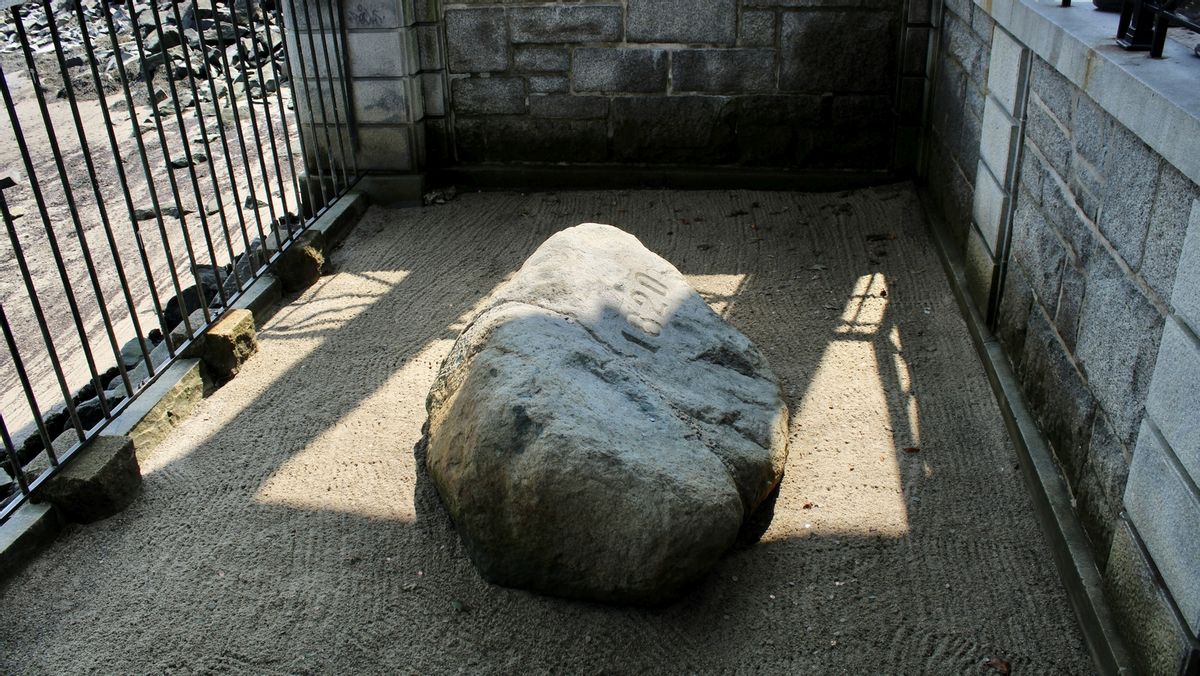If you had to pick the five most important rocks in the world, in no particular order, the list might look something like this: the Rosetta Stone, which helped archaeologists decipher hieroglyphs; the Black Stone in the Kaaba, a holy object for the world’s over 1 billion Muslims; the Stone of Scone, used in British coronation ceremonies since 1296 (and even earlier in Scotland); the Blarney Stone, which can give you the gift of gab with a kiss; and Plymouth Rock, the first spot where the Mayflower landed in America in 1620 (according to legend, of course). But just how true is the legend of Plymouth Rock?
There are two main sources historians refer to when looking at the Mayflower trip: “Of Plymouth Plantation,” written by William Bradford, and “Mount’s Relation,” written mostly by Edward Winslow, although most historians suggest Bradford wrote some of “Mount’s Relation” as well. A mention of a large rock in either one would almost certainly be sufficient evidence that the legend is true. But before we get to those sources (and apologies for the slight cliffhanger there), we do need to clarify a few other things.
First: Plymouth, with or without the rock, was not the first place the Pilgrims landed. Historians have placed that spot somewhere near Provincetown, Massachusetts, because both “Mount’s Relation” and “Of Plymouth Plantation” describe the first landing taking place on a relatively narrow strip of land on Cape Cod — where Plymouth is not. In the early 1900s, the Cape Cod Pilgrim Memorial Association built the Pilgrim Monument, a 252-foot (77 meter) granite tower, to memorialize the events. That monument is in Provincetown, not in Plymouth.
Second: Plymouth Rock is not exactly one rock. In 1774, the rock was split in half, “horizontally, like a bagel,” wrote John McPhee in the New Yorker. The lower half remained where it was, but the upper half was moved to the town square. It sat there until 1834, when it moved to Pilgrim Hall. According to McPhee, the halves were reunited in 1880, the rock was mortared back together and the year 1620 was chiseled in. The repairs did not last. By 1989, the Commonwealth of Massachusetts announced that they needed a mason to repair Plymouth Rock, the story of which makes up half of McPhee’s article.
But it was not the upper half that required the work done to maintain Plymouth Rock over the years. The lower half, which was not moved when the broke in 1774, became part of the surface of a wharf. As such, it was walked on, wheeled over and chiseled away by opportunistic tourists. So in 1880, when the rock was reassembled, the pieces didn’t exactly fit back together, explaining the liberal application of mortar that slowly fell apart, why the rock is much smaller today, and why it’s not really one rock anymore.
Third: A very old man said it was the rock the Pilgrims landed on. In 1741, 94-year-old church elder Thomas Faunce, heard that the large boulder near the shore was going to be buried to make room for a wharf. He ordered to be driven down to the boulder, and sat in a chair next to Plymouth Rock. As a crowd gathered, Faunce explained that this was the landing point for the original settlers, and they should respect that.
Faunce’s protest came 121 years after the original landing. And yet ... his father arrived at the settlement in 1623. Thomas Faunce was born in Plymouth in 1647. He almost certainly interacted with some of the original Pilgrims. McPhee notes that Faunce was keeper of the records in Plymouth for thirty-eight years.
All of this circles back to the two surviving published sources.
Neither of them mentions the rock. Nobody bothered to write it down. A 1962 article in American Heritage claims the earliest reference to the rock in general is from a 1715 boundary survey, but that’s still 95 years after the original landing.
So, did the Mayflower land on Plymouth Rock? Thomas Faunce had almost zero reason to lie. On the other hand, none of the surviving primary sources mention landing on a rock. We just don’t know. And since we just don’t know, we’d like to pose a different question: Does it truly matter?
Tell all the truth but tell it slant —
Success in Circuit lies
Too bright for our infirm Delight
The Truth's superb surprise
As Lightning to the Children eased
With explanation kind
The Truth must dazzle gradually
Or every man be blind —
— Emily Dickinson
